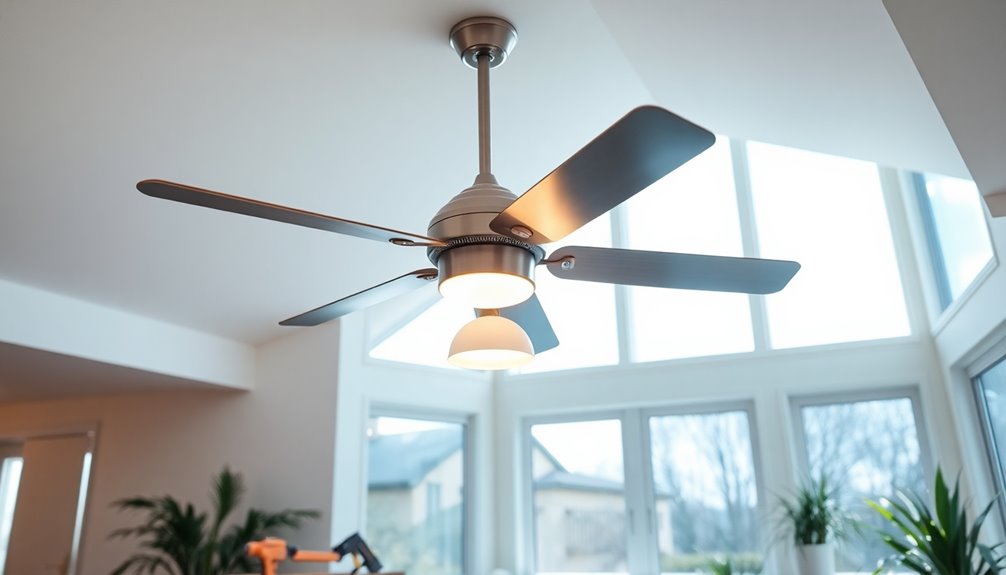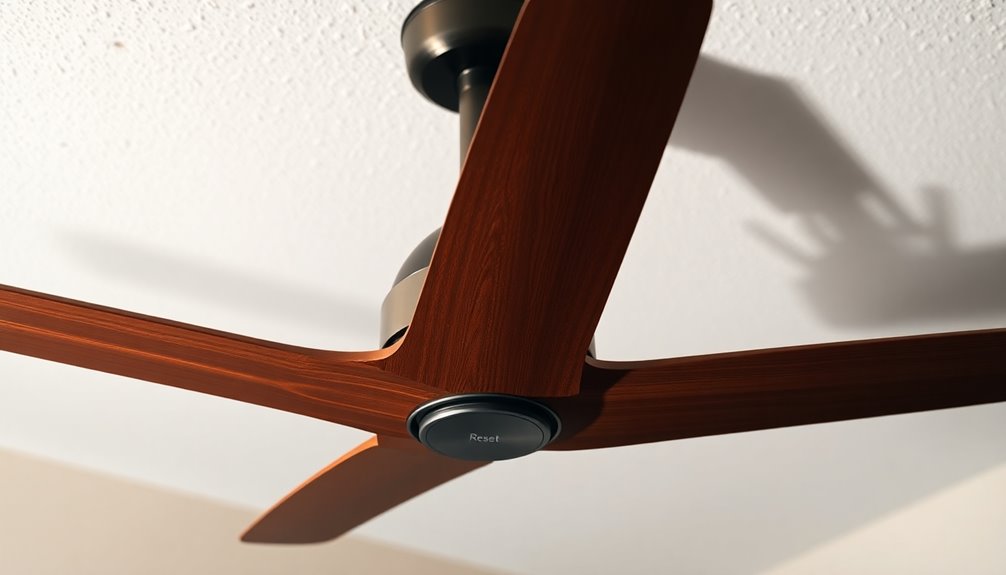Yes, a ceiling fan does need a ground wire to keep you safe and comply with electrical codes. Ground wires act as a pathway for stray electricity, reducing the risk of electric shock and preventing damage from power surges. If you install a ceiling fan without proper grounding, you greatly increase the risk of serious injury. Additionally, local building codes mandate grounding for safety reasons. Should you find yourself in an older home without grounding, there are alternative methods available. There's a lot more to explore about safe installation practices, so stick around for more details.
Key Takeaways
- Yes, a ceiling fan needs a ground wire to ensure safety by providing a path for stray electricity to dissipate.
- Grounding reduces the risk of electric shock by preventing the fan's casing from becoming electrified during a fault.
- Compliance with local building codes and the NEC requires proper grounding for ceiling fan installations.
- Lack of a ground wire increases the risk of equipment damage from electrical surges and complicates insurance claims.
- Alternative safety measures, like GFCI outlets, cannot replace the need for a ground wire in ceiling fan installations.
Importance of Ground Wires

Ground wires play an essential role in electrical safety, especially when it comes to ceiling fans. They provide a safe path for stray electricity to dissipate into the ground, considerably reducing the risk of electric shock. When a ceiling fan is properly grounded, it helps guarantee that if a fault occurs, stray electricity won't electrify the metal casing.
Without a ground wire, anyone who touches the fan could face serious electrocution risks.
The National Electrical Code (NEC) mandates the use of grounding for many electrical installations, including ceiling fans. This requirement isn't just a formality; it's vital for your safety and the longevity of your electrical devices. Ground wires protect against potential equipment damage caused by power surges or faults, keeping your ceiling fan and other appliances running smoothly.
Moreover, local building codes may require grounding for ceiling fixtures. By complying with these regulations, you not only enhance safety but also avoid potential penalties during inspections.
As a result, prioritizing a ground wire in your ceiling fan installation is a key step in guaranteeing a safe and efficient electrical system in your home.
Installation Without Ground Wire

Installing a ceiling fan without a ground wire can pose risks, particularly when it comes to electrical shocks.
You should consider alternative safety measures, like connecting to a grounded outlet or using a GFCI breaker, to enhance protection.
Additionally, be aware that local codes may require a ground connection, so check compliance before proceeding.
Risks of No Grounding
One notable risk of installing a ceiling fan without a ground wire is the increased chance of electric shock. If a ground fault occurs, the ceiling fan's casing could become electrified, putting you at risk when you touch it. Without that essential ground wire, you lack a safe path for electrical current, greatly raising the risk of serious injury or even death due to electrical shock.
Moreover, not having a grounding wire can lead to equipment damage. Electrical surges may not be redirected safely, which could void warranties and complicate any insurance claims you might need to file.
This situation becomes even more critical in older homes, where the electrical systems may not have grounding, making your installation non-compliant with current safety codes.
Finally, remember that installing a ceiling fan without a ground wire can lead to fines or penalties for violating local building codes. These codes exist to maintain occupant safety, so ignoring them puts you and your household at risk.
Always prioritize safety by verifying a proper ground wire is in place before proceeding with your ceiling fan installation.
Alternative Safety Measures
If you find yourself in a situation where a ceiling fan must be installed without a ground wire, there are several safety measures you can take to minimize risks.
First and foremost, confirm your installation meets safety standards. Look for a UL listing on the fan to validate compliance with safety regulations.
Next, think about incorporating a Ground Fault Circuit Interrupter (GFCI) outlet or breaker. This added safety feature helps protect against electrical shocks by cutting off power when it detects a ground fault.
Here are three additional safety measures to think about:
- Double Insulation: Choose a ceiling fan designed with double insulation, which acts as an extra barrier against electrical faults.
- Alternative Grounding Solutions: If feasible, connect the fan's mounting bracket to a nearby grounded outlet or use a ground wire from another circuit.
- Regular Inspections: Regularly inspect your fan and electrical connections for wear or damage, helping to identify potential hazards in the absence of a ground wire.
Code Compliance Issues
Compliance with electrical codes is essential when it comes to installing ceiling fans, especially in regards to grounding. The National Electrical Code (NEC) mandates that ceiling fixtures, including fans, must be grounded to guarantee safety and meet code compliance.
Installing a ceiling fan without a ground wire is a violation of these codes, which can lead to serious risks during inspections or in the event of electrical faults.
In older homes, you might find a lack of grounding, but modern installations typically require a ground wire to protect against electrical hazards. While replacing existing outlets with GFCI outlets can enhance safety, it doesn't substitute the need for a ground wire in fan installations.
Remember, failure to meet grounding requirements can result in fines or penalties during inspections, emphasizing the importance of adhering to local electrical codes.
Ultimately, validating your ceiling fan installation follows the necessary grounding requirements not only keeps you compliant but also promotes safety in your home.
Don't take shortcuts; always prioritize proper grounding to avoid complications and guarantee a safe living environment.
Safety Risks of Missing Ground

The absence of a ground wire in your ceiling fan installation poses significant safety risks that shouldn't be overlooked. Without a ground wire, if a ground fault occurs, the fan casing can become electrified, increasing the likelihood of electrical shock. This situation can be particularly dangerous, especially if insulation on hot wires fails.
Here are three key safety risks associated with missing a ground wire in ceiling fans:
- Increased Risk of Electrical Shock: Without grounding, you expose yourself to potentially fatal shocks if something goes wrong.
- Severe Injury or Fatality: Ground faults in non-grounded fans can lead to serious injuries or even death, with fatalities reported annually from electrical shocks linked to non-grounded appliances.
- Complicated Insurance Claims: If an accident occurs, having a non-grounded ceiling fan may complicate your insurance claims and void warranties.
While ceiling fans can operate without a ground wire, prioritizing safety is essential.
Installing Ground Fault Circuit Interrupter (GFCI) breakers can provide an additional layer of protection against these risks, ensuring your home remains safe and secure from electrical hazards.
Code Compliance and Regulations

Grounding your ceiling fan isn't just a safety measure; it's a requirement under the National Electrical Code (NEC). The NEC mandates that all permanent electrical installations, including ceiling fans, must be grounded to protect against electrical faults and shock hazards.
When you're dealing with electrical wiring, code compliance is vital for guaranteeing your home meets safety standards. Local building codes may have additional grounding requirements that can vary by jurisdiction, so it's important to consult local regulations during your installation.
If your home is older, it might lack proper grounding in its electrical systems. However, updated codes typically require that any new installations, like ceiling fans, comply with current safety standards.
Failing to comply with these electrical codes regarding grounding can result in fines or penalties, emphasizing the significance of adhering to these regulations for your safety.
While installing a Ground Fault Circuit Interrupter (GFCI) outlet can provide an alternative safety measure when grounding isn't feasible, it doesn't replace the necessity of a proper ground wire in ceiling fan installations.
Always prioritize code compliance to guarantee your ceiling fan is both safe and legal.
Alternative Grounding Solutions

If your ceiling fan doesn't have a dedicated ground wire, you can connect a ground wire from a nearby grounded outlet to enhance safety.
Another option is to install a ground screw in the mounting bracket, which can provide a grounding solution if the junction box is ungrounded.
Both methods can help guarantee your fan operates safely and effectively.
Grounding From Nearby Circuit
When your ceiling fan doesn't have a dedicated ground wire, connecting a grounding wire from a nearby grounded circuit can enhance safety and functionality. This alternative grounding solution can use a green or bare copper wire to link the fan's grounding point to a grounded outlet or box nearby.
Before proceeding, it's essential to verify that the nearby circuit can accommodate this additional grounding without violating electrical codes.
Here are three important steps to follow:
- Check the Grounding: Use a multimeter to verify that the nearby circuit is properly grounded before making any connections.
- Consult a Professional: Always consult a licensed electrician to guarantee compliance with local electrical codes and to safely establish grounding from the adjacent circuit.
- Secure Connections: Make certain all connections are tight and secure to prevent potential electrical hazards.
Installing Ground Screw Option
A ground screw can be a practical alternative for guaranteeing your ceiling fan is safely grounded, especially in older homes lacking a dedicated ground wire. When installing a ceiling fan, you can secure the ground screw to the metal bracket, allowing the fan to connect to your home's grounding system. This method is essential for safety, as it helps prevent electrical faults.
Before you proceed, always verify that the mounting bracket is metal and properly grounded. This step is critical for compliance with safety codes. Once confirmed, you can attach the ground screw to the metal bracket, making sure it's tightly secured.
Connect a grounding wire from your electrical system to the ground screw to enhance the safety of your installation. Using a ground screw not only provides an alternative grounding solution but also enhances the stability of your ceiling fan installation.
This approach is particularly beneficial when a dedicated ground wire isn't available in the ceiling junction box, helping to reduce potential shock hazards. By following these steps, you can guarantee your ceiling fan operates safely and effectively.
Expert Installation Recommendations

Installing a ceiling fan involves several critical steps to confirm safety and functionality. First and foremost, ascertain that the junction box is rated specifically for fan use and is securely mounted. This prevents accidents and guarantees stability during operation.
Next, always consult the manufacturer's instructions for specific wiring requirements since different ceiling fan models require unique installation approaches.
Here are three essential expert recommendations:
- Check Existing Wiring: Verify the condition of your wiring before proceeding. Damaged or outdated wiring can lead to serious safety hazards.
- Consider Grounding Options: If a ground wire is absent, using a GFCI breaker can provide an additional layer of safety against electrical shock.
- Hire a Professional: If you're unsure about wiring or grounding requirements, it's best to hire a licensed electrician. They can confirm that everything is installed correctly and safely.
Frequently Asked Questions
Is Ground Wire Necessary for a Ceiling Fan?
When you're installing a ceiling fan, you might wonder if a ground wire's necessary. While some fans operate without it, especially double-insulated models, it's generally recommended to have one for safety.
A ground wire protects against electrical shocks by providing a path for stray electricity. Local codes may vary, but for peace of mind, it's best to consult a licensed electrician to guarantee your installation meets safety standards.
Your safety matters!
What Happens if You Do Not Connect the Ground Wire?
Imagine riding a bike without a helmet. It might feel fine at first, but the risks increase considerably.
If you don't connect the ground wire for your ceiling fan, you're exposing yourself to potential electric shock if insulation fails. The fan could operate, but without grounding, the safety features are compromised, much like biking without protection.
You could face insurance issues too, making it essential to guarantee that ground wire's connected for safety.
Will a Ceiling Light Work Without a Ground Wire?
Yes, a ceiling light can work without a ground wire, but it's not safe.
While the light may illuminate, the risk of electric shock increases considerably if there's a fault in the electrical system.
You should check local building codes, as many require a ground wire for safety.
If you're using a light with double insulation, that might be okay, but it's always best to prioritize safety by including a ground wire.
Do You Really Need a Ground Wire?
Did you know that nearly 30% of electrical accidents in homes are linked to improper grounding? You really need a ground wire for safety.
It helps prevent electrical shocks, especially if something goes wrong with your wiring. While some devices might work without it, you're risking a serious hazard.
Local codes often require grounding, so it's best to follow those rules to keep yourself and your home safe from potential dangers.
Conclusion
In the end, while you might think skipping the ground wire is a small detail, it can lead to big risks. Ground wires aren't just about compliance; they're your safety net against electrical shock and fire hazards. So, why gamble with your safety? Whether you're installing a ceiling fan or any electrical fixture, remember that a little precaution today can prevent a disaster tomorrow. Don't leave your home's safety to chance; always prioritize proper installation.









